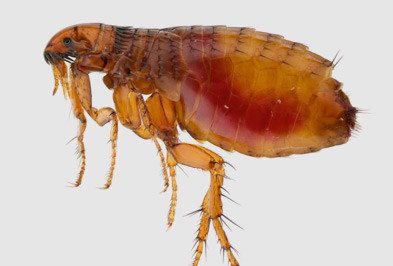Fleasdeveloper2022-11-15T12:43:07-05:00
Fleas
Color: Reddish-brown
Characteristics: Flat, hard bodies. Long hind legs.
Size: 1/6-1/12th of an inch in length
Potentially Dangerous: Yes

Bites & Stings

Blood Sucking

Difficult to Eradicate

Difficult to See

Hitchhiking
What Are Fleas?
Fleas are tiny (1/12 – 1/6 of an inch), flightless parasites that feed off warm-blooded animals. Their hind legs allow for very powerful jumps – up to eight inches vertically. They are typically reddish in color and get even darker red after feeding. For pet owners, fleas can be a nightmare.
Why Do I Have Them?
Fleas find their way into your home by traveling on a host – most often your pet. After wandering around outside, cats and dogs can easily pick up fleas that are introduced by passing wildlife. Unfortunately, this isn’t the only way they can get in. You can also pick up fleas if they attach onto your clothing or person.
Are They Dangerous?
Fleas don’t just leave behind painful, itchy bites – they are dangerous to both people and pets. A flea that has hosted on many different species throughout its life is likely to carry and transmit diseases such as plaque and murine typhus, and occasionally are intermediate hosts for dog and rodent tapeworm.
How Do I Get Rid Of Fleas?
Once you have a flea problem, it can be incredibly difficult to eradicate. Treating your pets is one of the most important steps – so contact your veterinarian to see what types of flea products or treatments they advise. The next step is to seek out professional flea control. Wil-Kil offers one-time flea control treatment to eradicate fleas in your home.
Can I Do It Myself?
DIY methods of flea control are not always effective. Many of them only address fleas on pets or adult fleas around the home, which may result in re-infestation. A professional treatment will also include Insect Growth Regulators so the eggs and immature fleas cannot develop into reproductive adults. Our Wil-Kil professionals are trained to identify common areas of infestation and will implement effective measures to control flea populations on your property.
Is the Treatment Safe?
We take the health and safety of our customers (and their pets) very seriously. We use products and treatments that are EPA registered for pest control use. All of our pest control professionals are licensed and certified by the state or local jurisdictions to ensure proper application.
How Soon Can You Get Here?
Our customers are our top priority. Your Wil-Kil technician is 100% committed to helping you as soon as possible.
How Do I Prevent This In The Future?
Fleas are difficult to prevent, but there are a few precautions you can take:
- Talk to your veterinarian about preventative flea treatments for pets.
- Don’t let pets sleep on beds or hang out on furniture.
- Vacuum carpet and other areas where pets spend time.
- Discourage wild animals from visiting your property by removing potential food sources, like bird feeders.
- Seal any holes or gaps on the exterior of the house to prevent mice (which are often hosts to fleas) from coming in.
- Check yourself and pets for fleas before going inside.
If you have a flea problem, the smartest choice is to contact professional flea control services. Get in touch with your local Milwaukee pest control company, Wil-Kil Pest Control.
Contact us today for more information!








